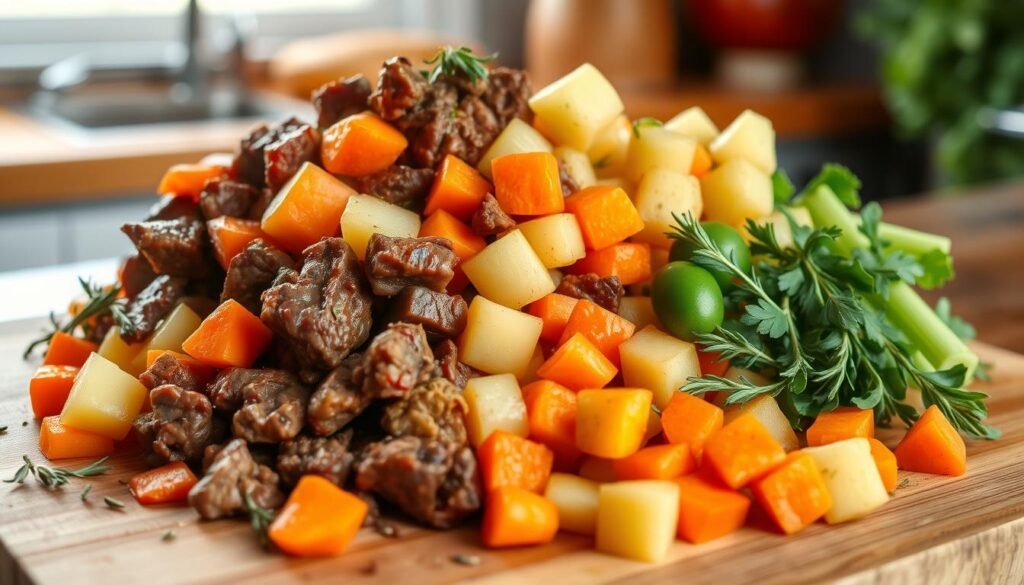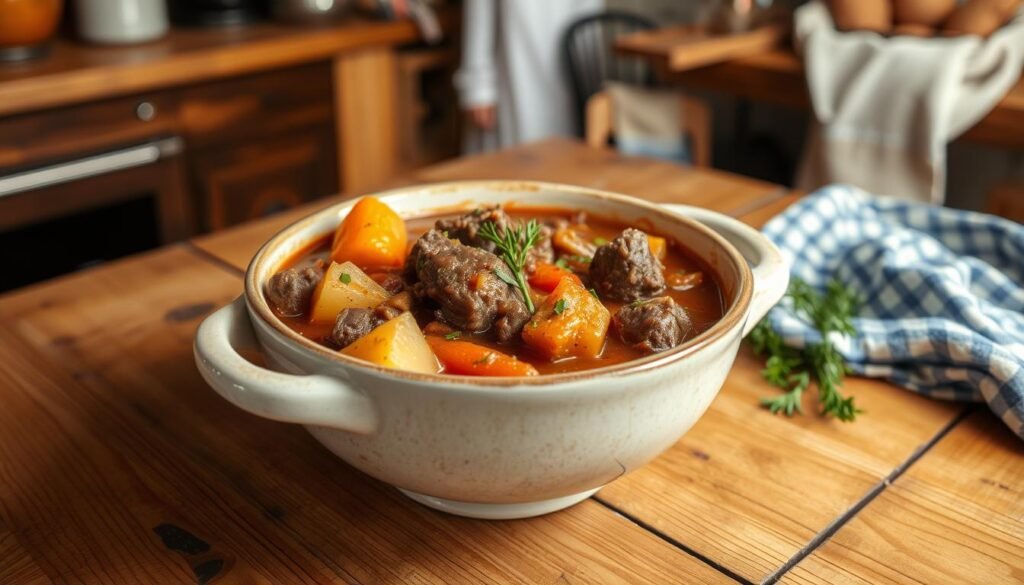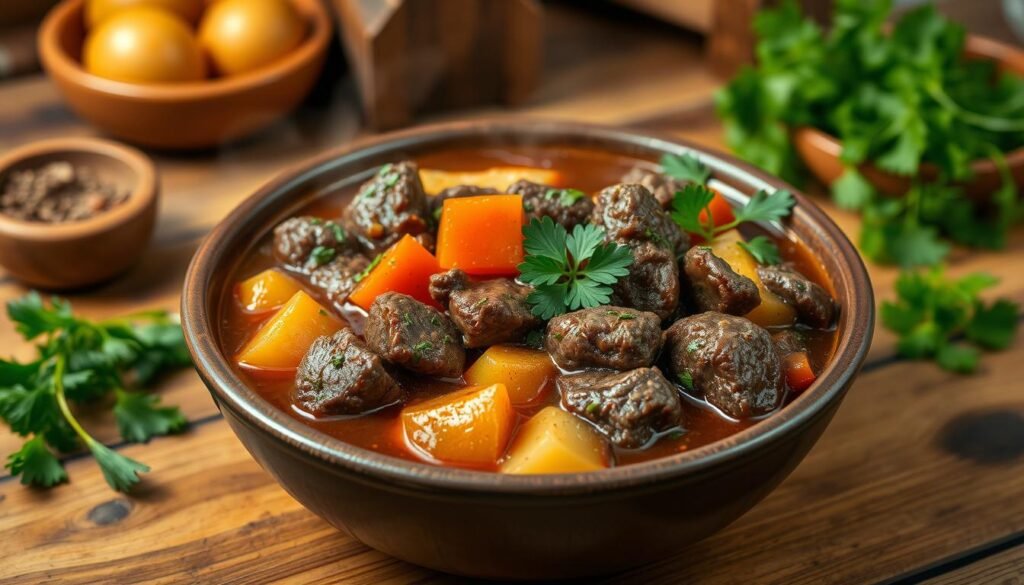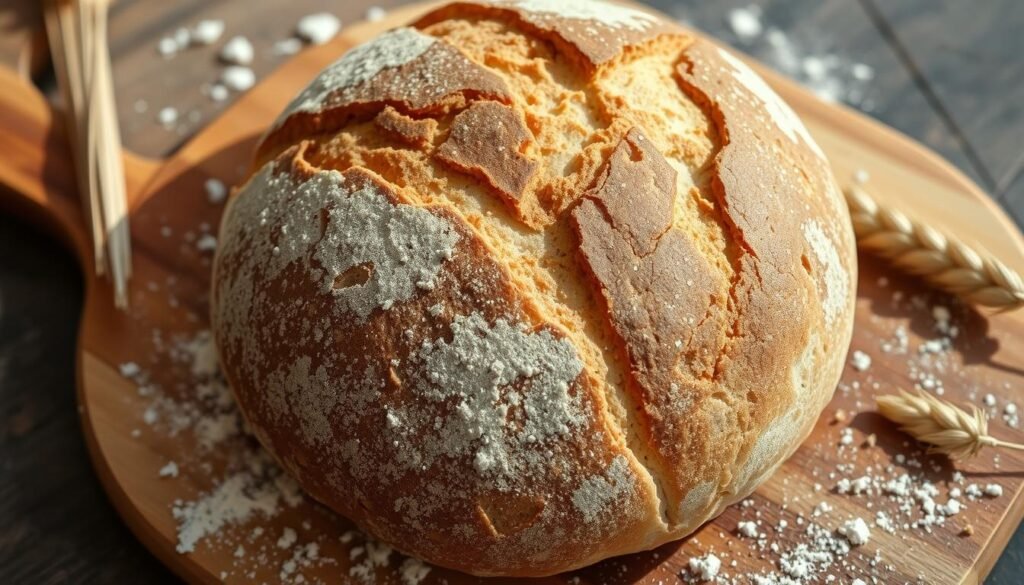Winter’s chill is the perfect time for a classic beef stew. It warms the soul and fills the belly. This dish is a true comfort food, with tender beef and a variety of vegetables in a rich broth.
Its flavors and aroma make it a favorite. It’s the perfect meal to bring families together and make your kitchen the heart of the home.
Key Takeaways
- Classic beef stew is a hearty, one-pot comfort meal perfect for cold weather.
- The recipe features tender beef chuck roast, seared until golden and then simmered in a rich broth.
- Vegetables like carrots, potatoes, and celery add texture and flavor to the stew.
- The stew has a high protein content and is a satisfying, nutritious meal.
- The recipe yields a substantial amount of servings, making it ideal for meal prep and leftovers.
Understanding the Art of Traditional Beef Stew
Beef stew comes from a long tradition of one-pot cooking. It’s a dish loved by many around the world. At its core is the chuck roast, a cut of beef known for its tenderness and flavor.
This cut of beef becomes incredibly tender when cooked slowly. It’s a key part of what makes beef stew so comforting.
The Benefits of Slow-Cooking Methods
Slow cooking is what makes beef stew special. The meat cooks in a flavorful broth, making it tender and juicy. This method also blends the flavors, making the stew irresistible.
Why Chuck Roast is the Perfect Cut
Quality Meat Scotland says chuck roast is the best cut for stew. It’s from the top shoulder and has the right mix of connective tissue and marbling. This makes it tender when cooked slowly.
As it cooks, the meat releases gelatin, adding to the stew’s creamy texture. This is what makes beef stew so delicious.
| Characteristic | Chuck Roast | Other Cuts |
|---|---|---|
| Tenderness | Meltingly tender after slow cooking | Can become tough if not cooked properly |
| Flavor | Rich, beefy flavor that infuses the entire stew | May not contribute as much depth of flavor |
| Texture | Succulent and gelatinous, thanks to the connective tissue | May result in a less velvety mouthfeel |
The beauty of traditional beef stew is how it turns simple ingredients into a feast of flavors and textures. The chuck roast is the star of this dish. By using slow cooking, cooks can make a meal that’s both comforting and nourishing.
Essential Ingredients for the Perfect Beef Stew
Creating a classic beef stew starts with the right ingredients. The heart of the dish is the beef, with chuck roast being the top choice. It offers a perfect mix of tenderness and flavor.
A mix of beef broth and red wine adds richness. Tomato paste and Worcestershire sauce bring depth and umami. Herbs like thyme and bay leaves add aromatic notes. Potatoes and peas add texture and nutrition.
| Ingredient | Quantity |
|---|---|
| Beef Chuck Roast | 3 pounds, cut into 1-inch pieces |
| Onion | 1 medium, diced |
| Carrots | 4 medium, peeled and sliced |
| Celery | 5 ribs, sliced |
| Potatoes | 1 1/2 pounds russet, peeled and cubed |
| Peas | 1 cup frozen |
| Beef Broth | 4 cups, low-sodium |
| Red Wine | 1 cup |
| Tomato Paste | 2 tablespoons |
| Worcestershire Sauce | 2 tablespoons |
| Thyme | 1 tablespoon, fresh or dried |
| Bay Leaves | 2 |
| Salt and Pepper | To taste |
With these ingredients, you’re set to make a flavorful beef stew. It will warm your soul and please your taste buds.
Mastering the Meat Preparation Technique
Making a delicious beef stew begins with the right meat prep. It’s important to choose the right beef cut and handle it well before cooking. Each step, from seasoning to searing, is crucial for bringing out the bold flavors that make this dish a comfort food favorite.
Proper Seasoning Methods
Start by drying the beef with paper towels for a good sear. Season it well with salt and pepper. This lets the seasonings soak into the beef and boost its natural taste.
The Importance of Searing
Searing the beef in batches is key. It adds a nice caramelized crust and more flavor to the stew. Cook in small batches to prevent steaming instead of searing. This simple step makes the beef truly special.
Creating the Perfect Flour Coating
Coating the beef in flour before cooking thickens the broth. This makes the stew velvety and rich. Toss the cubed beef in flour to coat evenly, then cook it in a hot pan. This step improves the stew’s texture.
“Proper meat preparation is the foundation of a truly exceptional beef stew. Taking the time to sear the beef and coat it in flour will elevate your dish to new heights of flavor and texture.”
The Role of Aromatics and Base Vegetables
At the heart of a classic beef stew are aromatic vegetables and base ingredients. These humble parts work together to add depth of taste. Onions, garlic, and celery, known as the “mirepoix” in French cooking, are sautéed. This releases their natural aromas and infuses the stew with a savory base.
Carrots add a sweet contrast to the rich, beefy flavors. Potatoes provide a hearty, starchy element that thickens the stew. These base vegetables not only add flavor but also soak up the broth, making every bite full of umami.
Properly sautéing these aromatics and base vegetables is key. Caramelizing onions and garlic unlocks complex flavors. The celery adds herbal notes, blending tastes and textures harmoniously.
As the stew simmers, these vegetables release their essence into the broth. This creates a richness that’s unmatched. The dish shows how simple, yet essential, ingredients can come together to make a comforting meal.

“The secret to a great beef stew lies in the careful selection and preparation of the aromatics and base vegetables. It’s the foundation upon which the entire dish is built.”
Creating a Rich and Flavorful Broth
The heart of a great beef stew is its broth. Start by picking a dry red wine like Cabernet Sauvignon or Pinot Noir. This adds depth and complexity. Then, use a strong beef broth for a wholesome, beefy base.
Add a bit of tomato paste to the broth for extra flavor. It brings a savory, umami taste that goes well with the other ingredients. Season it well with herbs like thyme and bay leaves for a fragrant, earthy flavor.
Balancing Herbs and Seasonings
Seasoning the stew right is crucial. Add herbs from the broth, plus garlic, Worcestershire sauce, or Dijon mustard. Taste and adjust until the flavors blend perfectly, making the dish even better.
Thickening Techniques
- Flour Coating: Coat the beef cubes in flour before searing. This thickens the stew as it cooks.
- Reduction: Let the stew simmer longer to reduce the liquid. This makes it thicker and more intense.
- Roux: Mix a flour-butter paste (roux) into the stew towards the end. It thickens it to your liking.
Mastering a rich, flavorful broth and balancing seasonings will make your beef stew a hit. It will warm your heart and delight your taste buds.
Adding Root Vegetables at the Right Time
When adding root vegetables to your beef stew, timing is everything. Potatoes, carrots, and other hardy veggies should go in about an hour before it’s done. This way, they stay tender but keep their texture, soaking up the flavorful broth.
Begin by searing the beef and sautéing the aromatics. Then, add the beef stock, wine, and seasonings. Let it simmer for 45 minutes to an hour. Next, add the root vegetables and cook for another 45 minutes to an hour. This ensures they’re cooked through but still have a nice bite.
| Ingredient | Quantity |
|---|---|
| Beef stew meat | 2 lbs |
| All-purpose flour | 1/3 cup |
| Olive oil | 3 Tablespoons |
| Salted butter | 3 teaspoons |
| Beef stock | 3 cups, divided |
| Red wine or beer (optional) | 1/3 cup |
| French shallots | 6, peeled and halved |
| Onions | 2 small, peeled and cut into 8 pieces |
| Fresh thyme leaves | 1 teaspoon (or 1/2 teaspoon dried) |
| Dried rosemary | 1/2 teaspoon, crumbled |
| Garlic | 2 cloves, minced |
| Rutabaga | 1 lb, peeled and cut into 1-inch cubes |
| Carrots | 3 medium, peeled and cut into coins |
| Dijon mustard | 1 teaspoon |
| Worcestershire sauce | 1 Tablespoon |
Adding root vegetables towards the end of cooking keeps them tender yet firm. This complements the rich beef perfectly. It’s a simple trick that makes your stew hearty and satisfying, especially on a cold day.
“The key to a perfectly cooked beef stew lies in the timing of the root vegetable additions. Get it right, and you’ll have a dish that’s a true delight for the senses.”
Perfecting the Cooking Process for Beef Stew
Mastering the cooking process is key to achieving the perfect beef stew. The secret lies in maintaining the right temperature and cooking duration. This ensures your beef is meltingly tender and the vegetables are cooked to perfection.
Temperature Control Guidelines
The key to a succulent beef stew is low and slow cooking. After bringing the stew to a boil, reduce the heat to low. Let it simmer for 2-3 hours. This long, gentle cooking process allows the beef to become fork-tender.
It also softens the vegetables and melds the flavors together.
Timing and Doneness Indicators
- Aim for a total cooking time of 2-3 hours for the best results.
- Check the beef for tenderness after 2 hours – it should be easily pierced with a fork.
- The vegetables should be soft but not falling apart when the stew is done.
- The broth will naturally thicken during the long simmering process, creating a rich, velvety texture.
Remember, the key to perfecting the cooking process for beef stew is patience and a watchful eye. By following these guidelines, you’ll be well on your way to creating a hearty, flavorful dish. It will warm you from the inside out.
Storage and Make-Ahead Tips
Beef stew is great for making ahead and enjoying over several meals. Its flavors get better with time, making it perfect for meal prep or leftovers. With a few easy storage tips, you can keep your beef stew fresh longer and enjoy it whenever you want.
Refrigerator Storage
Store beef stew in an airtight container in the fridge for 4-5 days. As it sits, the flavors will blend and get richer. When reheating, add a bit of water or broth if it’s too thick.
Freezer Storage
Freeze your beef stew in an airtight container for up to 3 months. It’s a great meal-prep option, letting you have quick, satisfying dinners ready. When reheating, do it gently to keep the meat and veggies tender.
Beef stew is the ultimate comfort food for making ahead. Follow these storage tips to enjoy its rich flavors for days or weeks. Whether in the fridge or freezer, your beef stew will be ready to warm you up whenever you need it.

Serving Suggestions and Pairings
There are many ways to enjoy a hearty bowl of classic beef stew. You can pair it with tasty side dishes and the right wine. This makes for a complete and satisfying meal.
Complementary Side Dishes
For a delicious meal, serve the stew with crusty bread, popovers, or dinner rolls. It also goes well with creamy mashed potatoes, egg noodles, or polenta. Adding fresh herbs like parsley adds a nice touch.
- Crusty Artisan Bread
- Fluffy Dinner Rolls
- Creamy Mashed Potatoes
- Buttery Egg Noodles
- Creamy Polenta
- Fresh Parsley (for garnish)
Wine Pairing Recommendations
Beef stew’s rich flavors need a full-bodied red wine. A bold Cabernet Sauvignon or spicy Syrah works well. These wines balance the stew’s richness with their tannins and acidity.
| Wine Varietal | Tasting Notes | Food Pairing |
|---|---|---|
| Cabernet Sauvignon | Rich, full-bodied, with notes of black fruit, cedar, and spice | Pairs well with the hearty flavors of beef stew |
| Syrah | Bold, with flavors of blackberry, black pepper, and a hint of smoke | Complements the savory, umami-rich notes of the stew |
Pairing your beef stew with the right side dishes and a glass of red wine makes for a cozy meal. It will delight your senses and warm your heart.
Conclusion
Classic beef stew is the ultimate comfort food, perfect for cold weather and family meals. It has rich flavors, tender meat, and hearty vegetables. This makes it a satisfying one-pot meal.
With proper techniques and quality ingredients, you can create a delicious stew. It gets better with time, making it great for meal prep and leftovers. This timeless dish is a favorite in kitchens across the United States.
Whether you’re a seasoned home cook or just starting, this classic recipe is sure to become a staple. By mastering slow cooking and layering flavors, you can make a comfort food masterpiece. So, gather your ingredients, fire up the stove, and get ready to savor the rich, hearty meal that is classic beef stew.
The key to a fantastic beef stew is attention to detail, quality ingredients, and patience. With this knowledge, you’re ready to create your own masterpiece in the kitchen. So, don’t hesitate to dive in and start simmering your way to a comforting and satisfying meal.



